Deck 6: Efficiency and Fairness of Markets
Question
Question
Question
Question
Question
Question
Question
Question
Question
Question
Question
Question
Question
Question
Question
Question
Question
Question
Question
Question
Question
Question
Question
Question
Question
Question
Question
Question
Question
Question
Question
Question
Question
Question
Question
Question
Question
Question
Question
Question
Question
Question
Question
Question
Question
Question
Question
Question
Question
Question
Question
Question
Question
Question
Question
Question
Question
Question
Question
Question
Question
Question
Question
Question
Question
Question
Question
Question
Question
Question
Question
Question
Question
Question
Question
Question
Question
Question
Question
Question

Unlock Deck
Sign up to unlock the cards in this deck!
Unlock Deck
Unlock Deck
1/130
Play
Full screen (f)
Deck 6: Efficiency and Fairness of Markets
1
Canned milk was only rationed to babies and small children during World War II. This rationing was an example of allocation by
A) force.
B) first-come, first-served.
C) market price.
D) personal characteristics.
E) sharing equally.
A) force.
B) first-come, first-served.
C) market price.
D) personal characteristics.
E) sharing equally.
personal characteristics.
2
The tickets to the Rugby World Cup grand final are usually distributed to fans through a random selection of those people who registered on a website. The tickets are allocated by which method?
A) Personal characteristics
B) Lottery
C) First-come, first-served
D) Majority rule
E) Contest
A) Personal characteristics
B) Lottery
C) First-come, first-served
D) Majority rule
E) Contest
Lottery
3
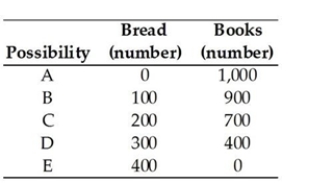
The table above shows the production possibilities for an economy. When the economy produces a combination of 900 books and 50 loaves of bread,
A) production efficiency is not achieved.
B) allocative and production efficiency are both achieved.
C) production efficiency is not achieved but allocative efficiency might be achieved.
D) production efficiency occurs because resources are not overused.
E) allocative efficiency is achieved because both goods are produced.
production efficiency is not achieved.
4
The resource allocation method used for the online auctions on eBay is
A) lottery.
B) market price.
C) first-come, first-served.
D) sharing equally.
E) contest.
A) lottery.
B) market price.
C) first-come, first-served.
D) sharing equally.
E) contest.

Unlock Deck
Unlock for access to all 130 flashcards in this deck.
Unlock Deck
k this deck
5
The organisers of the Australian Open randomly draw a few people from hundreds of applicants to compete in the junior section of the championship. The method of allocation for the opportunity to participate in competition is ________, and the method of allocation for determining the winner of the competition is ________.
A) contest; command
B) first-come, first-served; lottery
C) contest; lottery
D) lottery; contest
E) lottery; first-come, first-served
A) contest; command
B) first-come, first-served; lottery
C) contest; lottery
D) lottery; contest
E) lottery; first-come, first-served

Unlock Deck
Unlock for access to all 130 flashcards in this deck.
Unlock Deck
k this deck
6
If you split your dessert with your date, you are using a ________ allocation method.
A) sharing equally
B) first-come, first-served
C) command
D) contest
E) personal characteristics
A) sharing equally
B) first-come, first-served
C) command
D) contest
E) personal characteristics

Unlock Deck
Unlock for access to all 130 flashcards in this deck.
Unlock Deck
k this deck
7
To achieve allocative efficiency, an economy
A) must have increases in technology.
B) can produce either on or within its PPF.
C) might leave some resources unemployed.
D) does not necessarily need to be production efficient.
E) must produce on its PPF.
A) must have increases in technology.
B) can produce either on or within its PPF.
C) might leave some resources unemployed.
D) does not necessarily need to be production efficient.
E) must produce on its PPF.

Unlock Deck
Unlock for access to all 130 flashcards in this deck.
Unlock Deck
k this deck
8
Which of the following situations describing a resource allocation method most resembles the market price method?
A) Food from the Salvation Army Food Bank is distributed to families in need.
B) Seventy per cent of Austin's chess club wanted to purchase new chess sets and thirty per cent did not. The club purchased the sets.
C) Lattes are sold at Starbucks.
D) Jose works at Intel. His manager tells him what work needs to be completed each month.
E) Matt's mother has the rule that whoever cuts the cake chooses their slice last.
A) Food from the Salvation Army Food Bank is distributed to families in need.
B) Seventy per cent of Austin's chess club wanted to purchase new chess sets and thirty per cent did not. The club purchased the sets.
C) Lattes are sold at Starbucks.
D) Jose works at Intel. His manager tells him what work needs to be completed each month.
E) Matt's mother has the rule that whoever cuts the cake chooses their slice last.

Unlock Deck
Unlock for access to all 130 flashcards in this deck.
Unlock Deck
k this deck
9
Marginal benefit is the benefit that a person receives from consuming
A) all of the possible units of a good or service that can be consumed.
B) one more unit of a good or service.
C) only goods and services that are free.
D) one more unit of a good, and is equal to the cost of producing the unit of the good.
E) a good or service until the person has grown tired of it.
A) all of the possible units of a good or service that can be consumed.
B) one more unit of a good or service.
C) only goods and services that are free.
D) one more unit of a good, and is equal to the cost of producing the unit of the good.
E) a good or service until the person has grown tired of it.

Unlock Deck
Unlock for access to all 130 flashcards in this deck.
Unlock Deck
k this deck
10
Myer has a small number of 'Black Fridays' (that is, days when people do not shop, such as the day after Christmas Day). So, to get people to shop, Myer offers special items on sale at prices that are well below their usual prices. When Myer opens at 7am on Boxing Day, Myer is using a ________ allocation method for these items.
A) market price
B) contest
C) majority rule
D) command
E) first-come, first-served
A) market price
B) contest
C) majority rule
D) command
E) first-come, first-served

Unlock Deck
Unlock for access to all 130 flashcards in this deck.
Unlock Deck
k this deck
11
As more of a good is consumed, the marginal benefit of the good
A) decreases.
B) increases.
C) first decreases and then increases.
D) remains constant.
E) is unpredictable.
A) decreases.
B) increases.
C) first decreases and then increases.
D) remains constant.
E) is unpredictable.

Unlock Deck
Unlock for access to all 130 flashcards in this deck.
Unlock Deck
k this deck
12
In general, the marginal benefit curve
A) has a negative slope.
B) has a positive slope.
C) is concave.
D) is vertical.
E) is horizontal.
A) has a negative slope.
B) has a positive slope.
C) is concave.
D) is vertical.
E) is horizontal.

Unlock Deck
Unlock for access to all 130 flashcards in this deck.
Unlock Deck
k this deck
13
The chair of the Department of Economics at Melbourne University decided that office space is for tenured staff and that graduate students are required to share cubicles. What method is used to allocate office space?
A) Command
B) First-come, first-served
C) Majority rule
D) Sharing equally
E) Lottery
A) Command
B) First-come, first-served
C) Majority rule
D) Sharing equally
E) Lottery

Unlock Deck
Unlock for access to all 130 flashcards in this deck.
Unlock Deck
k this deck
14
The marginal benefit of an apple is measured by
A) the opportunity cost of producing another apple.
B) the price of the apple.
C) the amount of another good a person is willing to give up to get one more apple.
D) the amount of another good a person must give up to get one more apple.
E) a point on the PPF.
A) the opportunity cost of producing another apple.
B) the price of the apple.
C) the amount of another good a person is willing to give up to get one more apple.
D) the amount of another good a person must give up to get one more apple.
E) a point on the PPF.

Unlock Deck
Unlock for access to all 130 flashcards in this deck.
Unlock Deck
k this deck
15
Allocative efficiency refers to
A) producing the goods and services most highly valued.
B) producing the maximum possible amount of output.
C) using the least amount of labour to produce output.
D) obtaining the least output with the most inputs.
E) producing at any point on the PPF.
A) producing the goods and services most highly valued.
B) producing the maximum possible amount of output.
C) using the least amount of labour to produce output.
D) obtaining the least output with the most inputs.
E) producing at any point on the PPF.

Unlock Deck
Unlock for access to all 130 flashcards in this deck.
Unlock Deck
k this deck
16
Seventy per cent of Austin's chess club wanted to purchase new chess sets and thirty per cent did not. The club purchased the sets. Which method of allocation best describes the choice to purchase the sets?
A) Force
B) Sharing equally
C) Command
D) Lottery
E) Majority rule
A) Force
B) Sharing equally
C) Command
D) Lottery
E) Majority rule

Unlock Deck
Unlock for access to all 130 flashcards in this deck.
Unlock Deck
k this deck
17
The Adelaide Football Club reserves 5,000 free tickets to each home football game for its members, but members must stand in line to receive their ticket. Football tickets are allocated through which method?
A) Force
B) First-come, first-served
C) Sharing equally
D) Personal characteristics
E) Market price
A) Force
B) First-come, first-served
C) Sharing equally
D) Personal characteristics
E) Market price

Unlock Deck
Unlock for access to all 130 flashcards in this deck.
Unlock Deck
k this deck
18
Allocating resources by the order of someone in authority is a ________ allocation method.
A) first-come, first-served
B) command
C) contest
D) market price
E) majority rule
A) first-come, first-served
B) command
C) contest
D) market price
E) majority rule

Unlock Deck
Unlock for access to all 130 flashcards in this deck.
Unlock Deck
k this deck
19
Usually, when you arrive at your favourite restaurant with your date, you have to wait 25 minutes for a table. This restaurant is allocating tables using which method?
A) Sharing equally
B) First-come, first-served
C) Command
D) Market price
E) Personal characteristics
A) Sharing equally
B) First-come, first-served
C) Command
D) Market price
E) Personal characteristics

Unlock Deck
Unlock for access to all 130 flashcards in this deck.
Unlock Deck
k this deck
20
Which of the following situations describing a resource allocation method most resembling the force method?
A) Lattes are sold at Starbucks.
B) Food from the Salvation Army Food Bank is distributed to families in need.
C) Mandy saved her pocket money to buy a 12 pack of Coke Cola. When Mandy's brother saw the soft drinks, he took four.
D) Jose works at Intel. His manager tells him what work needs to be completed each month.
E) Seventy per cent of Austin's chess club wanted to purchase new chess sets and thirty per cent did not. The club purchased the sets.
A) Lattes are sold at Starbucks.
B) Food from the Salvation Army Food Bank is distributed to families in need.
C) Mandy saved her pocket money to buy a 12 pack of Coke Cola. When Mandy's brother saw the soft drinks, he took four.
D) Jose works at Intel. His manager tells him what work needs to be completed each month.
E) Seventy per cent of Austin's chess club wanted to purchase new chess sets and thirty per cent did not. The club purchased the sets.

Unlock Deck
Unlock for access to all 130 flashcards in this deck.
Unlock Deck
k this deck
21
Which describes the economic meanings of value and price?
A) Value is the marginal benefit obtained and price is the dollars that must be paid.
B) Value is exchange worth minus marginal benefit and price is the dollars that must be paid.
C) Value refers to the dollars that must be paid and price refers to the cost of producing the good.
D) Value refers to the gain the producer gets from the good or service and price refers to the gain the consumer gets from the good or service.
E) They are the same and both mean the dollars that must be paid.
A) Value is the marginal benefit obtained and price is the dollars that must be paid.
B) Value is exchange worth minus marginal benefit and price is the dollars that must be paid.
C) Value refers to the dollars that must be paid and price refers to the cost of producing the good.
D) Value refers to the gain the producer gets from the good or service and price refers to the gain the consumer gets from the good or service.
E) They are the same and both mean the dollars that must be paid.

Unlock Deck
Unlock for access to all 130 flashcards in this deck.
Unlock Deck
k this deck
22
The marginal cost of a good or service
A) graphs as a positively sloped curve, so it cannot be derived from the production possibilities frontier, which is downward sloping.
B) can be derived from the production possibilities frontier.
C) can be calculated from the marginal benefit of that good or service.
D) decreases as more of the good or service is produced.
E) None of the above answers is correct.
A) graphs as a positively sloped curve, so it cannot be derived from the production possibilities frontier, which is downward sloping.
B) can be derived from the production possibilities frontier.
C) can be calculated from the marginal benefit of that good or service.
D) decreases as more of the good or service is produced.
E) None of the above answers is correct.

Unlock Deck
Unlock for access to all 130 flashcards in this deck.
Unlock Deck
k this deck
23
Which of the following is necessary for allocative efficiency to be achieved?
A) The difference between marginal benefit and marginal cost must be maximised.
B) Production must be at a point inside the production possibilities frontier.
C) Marginal benefit must be maximised.
D) Marginal benefit must equal marginal cost.
E) Marginal cost must be minimised.
A) The difference between marginal benefit and marginal cost must be maximised.
B) Production must be at a point inside the production possibilities frontier.
C) Marginal benefit must be maximised.
D) Marginal benefit must equal marginal cost.
E) Marginal cost must be minimised.

Unlock Deck
Unlock for access to all 130 flashcards in this deck.
Unlock Deck
k this deck
24
All points on the production possibilities frontier
A) are production inefficient.
B) are allocatively efficient but only one point achieves production efficiency.
C) are production efficient but only one point achieves allocative efficiency.
D) are allocatively inefficient.
E) achieve allocative efficiency.
A) are production inefficient.
B) are allocatively efficient but only one point achieves production efficiency.
C) are production efficient but only one point achieves allocative efficiency.
D) are allocatively inefficient.
E) achieve allocative efficiency.

Unlock Deck
Unlock for access to all 130 flashcards in this deck.
Unlock Deck
k this deck
25
Marginal cost equals
A) all the opportunity cost of producing the amount of output.
B) productive efficiency.
C) the profitability derived from producing another unit of output.
D) or exceeds the marginal benefit.
E) the opportunity cost of producing one more unit of output.
A) all the opportunity cost of producing the amount of output.
B) productive efficiency.
C) the profitability derived from producing another unit of output.
D) or exceeds the marginal benefit.
E) the opportunity cost of producing one more unit of output.

Unlock Deck
Unlock for access to all 130 flashcards in this deck.
Unlock Deck
k this deck
26
Allocative efficiency is achieved when the marginal benefit of a good
A) equals zero.
B) is less than its marginal cost.
C) is equal to its marginal cost.
D) exceeds the marginal cost regardless of how much the difference is.
E) exceeds the marginal cost by as much as possible.
A) equals zero.
B) is less than its marginal cost.
C) is equal to its marginal cost.
D) exceeds the marginal cost regardless of how much the difference is.
E) exceeds the marginal cost by as much as possible.

Unlock Deck
Unlock for access to all 130 flashcards in this deck.
Unlock Deck
k this deck
27
When the marginal cost of producing a bike is greater than the marginal benefit of the bike, for resource use to be allocatively efficient,
A) people must be educated to demand more bikes.
B) it must be determined if the production of bikes can be increased.
C) more bikes should be produced.
D) no more and no fewer bikes should be produced.
E) fewer bikes should be produced.
A) people must be educated to demand more bikes.
B) it must be determined if the production of bikes can be increased.
C) more bikes should be produced.
D) no more and no fewer bikes should be produced.
E) fewer bikes should be produced.

Unlock Deck
Unlock for access to all 130 flashcards in this deck.
Unlock Deck
k this deck
28
If the difference between the marginal benefit and the marginal cost of a good is as large as possible,
A) more of the good should be produced.
B) allocative efficiency has been attained.
C) resources are being used with maximum efficiency.
D) resources would create more value producing other goods and hence the production of this good should be decreased.
E) Both answers A and D are correct.
A) more of the good should be produced.
B) allocative efficiency has been attained.
C) resources are being used with maximum efficiency.
D) resources would create more value producing other goods and hence the production of this good should be decreased.
E) Both answers A and D are correct.

Unlock Deck
Unlock for access to all 130 flashcards in this deck.
Unlock Deck
k this deck
29
To achieve allocative efficiency, one must compare the
A) marginal cost to the production efficiency cost.
B) marginal benefit of a good to its marginal cost.
C) opportunity cost to the attainable point on the production possibilities frontier.
D) point of production efficiency to the point of allocative efficiency.
E) marginal cost of a good to its opportunity cost.
A) marginal cost to the production efficiency cost.
B) marginal benefit of a good to its marginal cost.
C) opportunity cost to the attainable point on the production possibilities frontier.
D) point of production efficiency to the point of allocative efficiency.
E) marginal cost of a good to its opportunity cost.

Unlock Deck
Unlock for access to all 130 flashcards in this deck.
Unlock Deck
k this deck
30
The marginal benefit of the first hotdog consumed is ________ the marginal benefit of the fifth hotdog consumed.
A) the inverse of
B) equal to
C) equal to 5 times
D) greater than
E) less than
A) the inverse of
B) equal to
C) equal to 5 times
D) greater than
E) less than

Unlock Deck
Unlock for access to all 130 flashcards in this deck.
Unlock Deck
k this deck
31
When society produces the combination of goods and services on the PPF that it values the most highly, society has
A) achieved only allocative efficiency and definitely not production efficiency.
B) achieved a free lunch.
C) perhaps achieved production efficiency and perhaps achieved allocative efficiency.
D) achieved only production efficiency and definitely not allocative efficiency.
E) achieved both production efficiency and allocative efficiency.
A) achieved only allocative efficiency and definitely not production efficiency.
B) achieved a free lunch.
C) perhaps achieved production efficiency and perhaps achieved allocative efficiency.
D) achieved only production efficiency and definitely not allocative efficiency.
E) achieved both production efficiency and allocative efficiency.

Unlock Deck
Unlock for access to all 130 flashcards in this deck.
Unlock Deck
k this deck
32
Value and price can be compared by noting that
A) value is what we must pay while price is what we are willing to pay.
B) value is always greater than price.
C) value is what the seller receives when we buy a good, and price is what we must pay when we buy a good.
D) price is what we must pay and value is what we are willing to pay.
E) they are the same thing.
A) value is what we must pay while price is what we are willing to pay.
B) value is always greater than price.
C) value is what the seller receives when we buy a good, and price is what we must pay when we buy a good.
D) price is what we must pay and value is what we are willing to pay.
E) they are the same thing.

Unlock Deck
Unlock for access to all 130 flashcards in this deck.
Unlock Deck
k this deck
33
The figure above shows Kaley's marginal benefit from swimming with manatees (manatee is another name for a sea cow or dugong) and Scott's marginal cost of providing manatee swimming tours. At 1 manatee swim per week, Kaley's marginal benefit is ________ and Scott's marginal cost is ________.
A) $10, $40
B) $25; $25
C) $40; $10
D) $40; $40
E) None of the above answers is correct.
A) $10, $40
B) $25; $25
C) $40; $10
D) $40; $40
E) None of the above answers is correct.

Unlock Deck
Unlock for access to all 130 flashcards in this deck.
Unlock Deck
k this deck
34
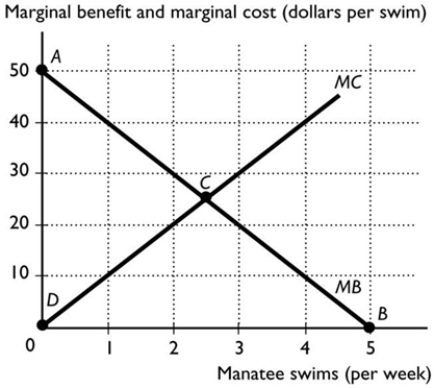
The figure above shows Kaley's marginal benefit from swimming with manatees (manatee is another name for a sea cow or dugong) and Scott's marginal cost of providing manatee swimming tours. If Scott offers two swim tours per week, he incurs a marginal cost of
A) $2.
B) more than $30.
C) $20.
D) $30.
E) $10.

Unlock Deck
Unlock for access to all 130 flashcards in this deck.
Unlock Deck
k this deck
35
To an economist, 'value' is the same as
A) the minimum price that people are willing to pay for another unit of the good.
B) total surplus.
C) marginal benefit.
D) marginal cost.
E) consumer surplus.
A) the minimum price that people are willing to pay for another unit of the good.
B) total surplus.
C) marginal benefit.
D) marginal cost.
E) consumer surplus.

Unlock Deck
Unlock for access to all 130 flashcards in this deck.
Unlock Deck
k this deck
36
Which of the following are the rules for finding the point of allocative efficiency?
A) Produce on the PPF and then produce where the marginal benefit and marginal cost are as large as possible.
B) Produce on the PPF and then produce where marginal benefit equals marginal cost.
C) Produce anywhere on the PPF.
D) Produce on the PPF and then produce where the marginal benefit exceeds marginal cost by as much as possible.
E) Produce on the PPF and then produce where marginal benefit and marginal cost are constant.
A) Produce on the PPF and then produce where the marginal benefit and marginal cost are as large as possible.
B) Produce on the PPF and then produce where marginal benefit equals marginal cost.
C) Produce anywhere on the PPF.
D) Produce on the PPF and then produce where the marginal benefit exceeds marginal cost by as much as possible.
E) Produce on the PPF and then produce where marginal benefit and marginal cost are constant.

Unlock Deck
Unlock for access to all 130 flashcards in this deck.
Unlock Deck
k this deck
37
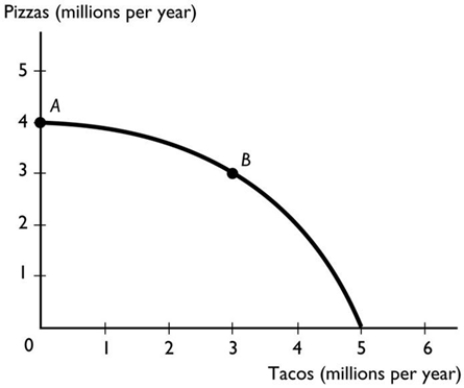
The figure above shows a nation's production possibilities frontier. If the marginal cost equals the marginal benefit at point A when 4 million pizzas are produced,
A) production efficiency is achieved but allocative efficiency is not achieved because there are no tacos being produced.
B) production efficiency is achieved but allocative efficiency is not achieved because the number of tacos produced is at its absolute maximum.
C) allocative efficiency is achieved but production efficiency is not achieved because there are no tacos being produced.
D) both allocative and production efficiency are achieved.
E) neither allocative nor production efficiency has been achieved.

Unlock Deck
Unlock for access to all 130 flashcards in this deck.
Unlock Deck
k this deck
38
The marginal cost curves slope upward because of the principle of
A) decreasing total benefit.
B) increasing marginal cost.
C) increasing marginal benefits.
D) decreasing marginal cost.
E) decreasing marginal benefits.
A) decreasing total benefit.
B) increasing marginal cost.
C) increasing marginal benefits.
D) decreasing marginal cost.
E) decreasing marginal benefits.

Unlock Deck
Unlock for access to all 130 flashcards in this deck.
Unlock Deck
k this deck
39
In general, the marginal cost curve
A) is vertical.
B) is U-shaped.
C) has a positive slope.
D) is horizontal.
E) has a negative slope.
A) is vertical.
B) is U-shaped.
C) has a positive slope.
D) is horizontal.
E) has a negative slope.

Unlock Deck
Unlock for access to all 130 flashcards in this deck.
Unlock Deck
k this deck
40
Allocative efficiency occurs when
A) all citizens have equal access to goods and services.
B) the most highly valued goods and services are produced.
C) goods and services are free.
D) the environment is protected at all costs.
E) production takes place at any point on the PPF.
A) all citizens have equal access to goods and services.
B) the most highly valued goods and services are produced.
C) goods and services are free.
D) the environment is protected at all costs.
E) production takes place at any point on the PPF.

Unlock Deck
Unlock for access to all 130 flashcards in this deck.
Unlock Deck
k this deck
41
Samantha was willing to pay $10 for a hamburger because she was hungry but she only paid $2.50. What is the marginal benefit Samantha gained from the hamburger?
A) $2.50
B) $10.00
C) $12.50
D) $7.50
E) None of the above answers is correct.
A) $2.50
B) $10.00
C) $12.50
D) $7.50
E) None of the above answers is correct.

Unlock Deck
Unlock for access to all 130 flashcards in this deck.
Unlock Deck
k this deck
42
Suppose Dan is willing to pay a maximum of $3,000 for a piano, but finds one he can buy for $2,500. Dan's consumer surplus from this piano is
A) $5,500.
B) $2,500.
C) $3,000.
D) $500.
E) zero because he buys the piano.
A) $5,500.
B) $2,500.
C) $3,000.
D) $500.
E) zero because he buys the piano.

Unlock Deck
Unlock for access to all 130 flashcards in this deck.
Unlock Deck
k this deck
43
Jake just bought a new hockey stick. When he was leaving the shop, he thought he had such a great deal and would have paid $50 more dollars for the stick. Jake received
A) total surplus.
B) consumer surplus.
C) equilibrium.
D) marginal cost.
E) producer surplus.
A) total surplus.
B) consumer surplus.
C) equilibrium.
D) marginal cost.
E) producer surplus.

Unlock Deck
Unlock for access to all 130 flashcards in this deck.
Unlock Deck
k this deck
44
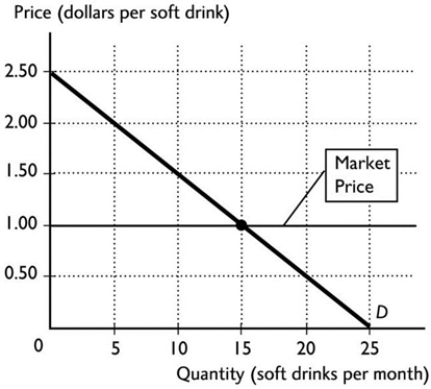
The figure above shows Diane's demand curve for soft drinks. The price of a soft drink is $1.00. Diane's consumer surplus from all 15 soft drinks is
A) $15.00.
B) $11.25.
C) $8.00.
D) $22.50.
E) $1.50.

Unlock Deck
Unlock for access to all 130 flashcards in this deck.
Unlock Deck
k this deck
45
Which of the following is an example of consumer surplus?
A) Sue would have paid $15 for a new compact disc but paid only $10.
B) Jose buys a hamburger for $2 and tells you he would not have paid a penny more.
C) Mary buys a pad of paper for $2 and finds the same good at another store for $1.50.
D) John believes the price he paid for his computer was too high.
E) Anne finds a mountain bike for which she is willing to pay a maximum of $550 and the price of the bike is $600.
A) Sue would have paid $15 for a new compact disc but paid only $10.
B) Jose buys a hamburger for $2 and tells you he would not have paid a penny more.
C) Mary buys a pad of paper for $2 and finds the same good at another store for $1.50.
D) John believes the price he paid for his computer was too high.
E) Anne finds a mountain bike for which she is willing to pay a maximum of $550 and the price of the bike is $600.

Unlock Deck
Unlock for access to all 130 flashcards in this deck.
Unlock Deck
k this deck
46
A demand curve can be interpreted as
A) an average benefit curve.
B) a marginal cost curve.
C) a marginal benefit curve.
D) a total benefit curve.
E) None of the above answers is correct.
A) an average benefit curve.
B) a marginal cost curve.
C) a marginal benefit curve.
D) a total benefit curve.
E) None of the above answers is correct.

Unlock Deck
Unlock for access to all 130 flashcards in this deck.
Unlock Deck
k this deck
47
Consumer surplus is the area
A) below the supply curve and above the market price.
B) above the demand curve and below the market price.
C) above the supply curve and below the market price.
D) below the demand curve and above the supply curve.
E) below the demand curve and above the market price.
A) below the supply curve and above the market price.
B) above the demand curve and below the market price.
C) above the supply curve and below the market price.
D) below the demand curve and above the supply curve.
E) below the demand curve and above the market price.

Unlock Deck
Unlock for access to all 130 flashcards in this deck.
Unlock Deck
k this deck
48
Which of the following statements is correct?
A) Consumer surplus equals the price paid for a good.
B) An increase in price decreases consumer surplus.
C) The consumer surplus from a good is always larger than the total benefit from the good.
D) The consumer surplus from a good or service must always equal producer surplus.
E) An increase in price has no effect on consumer surplus.
A) Consumer surplus equals the price paid for a good.
B) An increase in price decreases consumer surplus.
C) The consumer surplus from a good is always larger than the total benefit from the good.
D) The consumer surplus from a good or service must always equal producer surplus.
E) An increase in price has no effect on consumer surplus.

Unlock Deck
Unlock for access to all 130 flashcards in this deck.
Unlock Deck
k this deck
49
Consumers' total benefit from consuming a good is equal to the
A) consumer surplus minus the total amount spent on the good.
B) total amount spent on the good divided by the number of units purchased.
C) total amount spent on the good.
D) consumer surplus plus the total amount spent on the good.
E) consumer surplus on the quantity purchased.
A) consumer surplus minus the total amount spent on the good.
B) total amount spent on the good divided by the number of units purchased.
C) total amount spent on the good.
D) consumer surplus plus the total amount spent on the good.
E) consumer surplus on the quantity purchased.

Unlock Deck
Unlock for access to all 130 flashcards in this deck.
Unlock Deck
k this deck
50
Lauren and Katy each bought a new bike lock for $20. Both Lauren and Katy would have paid $25 for the lock. Katy's consumer surplus equalled
A) $20.
B) $50.
C) $5.
D) $40.
E) $10.
A) $20.
B) $50.
C) $5.
D) $40.
E) $10.

Unlock Deck
Unlock for access to all 130 flashcards in this deck.
Unlock Deck
k this deck
51
In the figure above, at the market price of $15, the consumer surplus equals
A) $10,000.
B) 2,000 units.
C) $40,000.
D) $20,000.
E) $30,000.
A) $10,000.
B) 2,000 units.
C) $40,000.
D) $20,000.
E) $30,000.

Unlock Deck
Unlock for access to all 130 flashcards in this deck.
Unlock Deck
k this deck
52
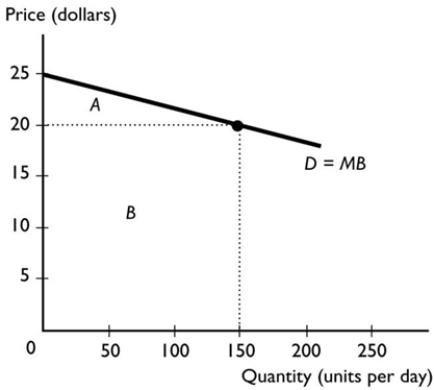
In the figure above, suppose that $20 is the market equilibrium price. What is the amount of the consumer surplus?
A) $375
B) 150 units
C) $3,000
D) $1,500
E) $3,375

Unlock Deck
Unlock for access to all 130 flashcards in this deck.
Unlock Deck
k this deck
53
Mark loves ice cream. At any point in time, he will buy an additional ice cream cone if
A) the marginal benefit from it is zero.
B) there is no deadweight loss produced by his purchase of a cone.
C) the marginal benefit from it exceeds the price.
D) his willingness to pay is less than the price.
E) None of the above answers is correct.
A) the marginal benefit from it is zero.
B) there is no deadweight loss produced by his purchase of a cone.
C) the marginal benefit from it exceeds the price.
D) his willingness to pay is less than the price.
E) None of the above answers is correct.

Unlock Deck
Unlock for access to all 130 flashcards in this deck.
Unlock Deck
k this deck
54
The consumer acquires a consumer surplus on a good if the marginal benefit is
A) less than the price.
B) greater than the price.
C) less than the marginal cost.
D) equal to the price.
E) zero.
A) less than the price.
B) greater than the price.
C) less than the marginal cost.
D) equal to the price.
E) zero.

Unlock Deck
Unlock for access to all 130 flashcards in this deck.
Unlock Deck
k this deck
55
If a seller charges a buyer the exact price the buyer is willing to pay, then the buyer would
A) receive the maximum consumer surplus.
B) receive no consumer surplus from that unit of the good.
C) receive no benefit from the good.
D) suffer a deadweight loss from buying the good.
E) not buy the good.
A) receive the maximum consumer surplus.
B) receive no consumer surplus from that unit of the good.
C) receive no benefit from the good.
D) suffer a deadweight loss from buying the good.
E) not buy the good.

Unlock Deck
Unlock for access to all 130 flashcards in this deck.
Unlock Deck
k this deck
56
A point on the demand curve shows the
A) maximum price that people are willing to pay for another unit of a good.
B) consumer surplus a person gains from consuming a unit of a good.
C) dollars' worth of other goods that people must sacrifice to consume another unit of the good.
D) minimum price that people are willing to pay for another unit of a good.
E) marginal benefit minus the consumer surplus from consuming another unit of a good.
A) maximum price that people are willing to pay for another unit of a good.
B) consumer surplus a person gains from consuming a unit of a good.
C) dollars' worth of other goods that people must sacrifice to consume another unit of the good.
D) minimum price that people are willing to pay for another unit of a good.
E) marginal benefit minus the consumer surplus from consuming another unit of a good.

Unlock Deck
Unlock for access to all 130 flashcards in this deck.
Unlock Deck
k this deck
57
The marginal benefit of each additional unit of a good consumed
A) increases as more is consumed.
B) will maximise consumer surplus.
C) is always equal to its marginal cost.
D) is equal to the deadweight loss if the unit of the good is not produced.
E) decreases as more is consumed.
A) increases as more is consumed.
B) will maximise consumer surplus.
C) is always equal to its marginal cost.
D) is equal to the deadweight loss if the unit of the good is not produced.
E) decreases as more is consumed.

Unlock Deck
Unlock for access to all 130 flashcards in this deck.
Unlock Deck
k this deck
58

In the figure above, suppose that $20 is the market equilibrium price. Which area is the consumer surplus?
A) A
B) B
C) B ÷ A
D) B - A
E) A + B

Unlock Deck
Unlock for access to all 130 flashcards in this deck.
Unlock Deck
k this deck
59
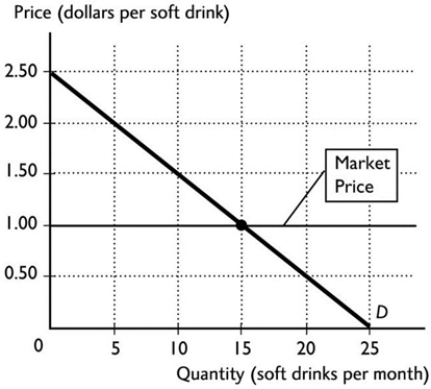
The figure above shows Diane's demand curve for soft drinks. The price of a soft drink is $1.00. Diane's consumer surplus from her 10th soft drink is
A) $2.50.
B) $1.50.
C) $0.50.
D) $1.00.
E) $0.00.

Unlock Deck
Unlock for access to all 130 flashcards in this deck.
Unlock Deck
k this deck
60
The price of a hat is $100. Willie is willing to pay $130, Waylon is willing to pay $100, and Merle is willing to pay $85. All of the following statements are true EXCEPT
A) Only Willie and Waylon will purchase the cowboy hat.
B) The sum of consumer surplus will be $30.
C) Merle's consumer surplus is $15.
D) Willie's consumer surplus is $30.
E) Waylon's consumer surplus is $0.
A) Only Willie and Waylon will purchase the cowboy hat.
B) The sum of consumer surplus will be $30.
C) Merle's consumer surplus is $15.
D) Willie's consumer surplus is $30.
E) Waylon's consumer surplus is $0.

Unlock Deck
Unlock for access to all 130 flashcards in this deck.
Unlock Deck
k this deck
61
In general, as the consumption of a good or service increases, the marginal benefit from consuming that good or service
A) stays the same.
B) increases.
C) decreases.
D) at first increases and then decreases.
E) at first decreases and then increases.
A) stays the same.
B) increases.
C) decreases.
D) at first increases and then decreases.
E) at first decreases and then increases.

Unlock Deck
Unlock for access to all 130 flashcards in this deck.
Unlock Deck
k this deck
62
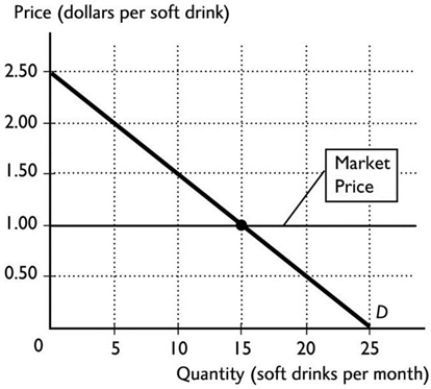
The figure above shows Diane's demand curve for soft drinks. The price of a soft drink is $1.00. Diane's total benefit from consuming 15 soft drinks is
A) $15.00.
B) $26.25.
C) $0.
D) $11.25.
E) None of the above answers is correct.

Unlock Deck
Unlock for access to all 130 flashcards in this deck.
Unlock Deck
k this deck
63
Which of the following describes the economic meanings of cost and price?
A) Cost refers to what the buyers pay for the good, and price refers to what sellers receive when the good is sold.
B) Cost is what must be given up to produce a good, and price is what a seller receives when the good is sold.
C) They are the same, and they both mean what is received when a good is sold.
D) Cost refers to the price that buyers must pay to buy the good.
E) Cost is exchange worth, and price is dollar worth.
A) Cost refers to what the buyers pay for the good, and price refers to what sellers receive when the good is sold.
B) Cost is what must be given up to produce a good, and price is what a seller receives when the good is sold.
C) They are the same, and they both mean what is received when a good is sold.
D) Cost refers to the price that buyers must pay to buy the good.
E) Cost is exchange worth, and price is dollar worth.

Unlock Deck
Unlock for access to all 130 flashcards in this deck.
Unlock Deck
k this deck
64
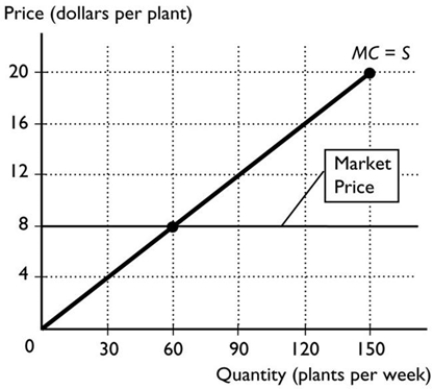
Bill and Krista sell potted plants from a roadside stand. The figure above shows Bill and Krista's marginal cost curve and the market price. If Bill and Krista sell 60 plants per week, their producer surplus from the 60th plant will equal
A) $0.
B) $480.
C) $20.
D) $8.
E) More information is needed to answer the question.

Unlock Deck
Unlock for access to all 130 flashcards in this deck.
Unlock Deck
k this deck
65
Producer surplus definitely exists when the
A) marginal benefit exceeds the marginal cost.
B) marginal cost exceeds the price.
C) price exceeds marginal benefit.
D) marginal benefit exceeds the price.
E) price exceeds marginal cost.
A) marginal benefit exceeds the marginal cost.
B) marginal cost exceeds the price.
C) price exceeds marginal benefit.
D) marginal benefit exceeds the price.
E) price exceeds marginal cost.

Unlock Deck
Unlock for access to all 130 flashcards in this deck.
Unlock Deck
k this deck
66
Suppose the price of a scooter is $200 and Zoe is willing to pay $250. Zoe's
A) consumer surplus from that scooter is $200.
B) marginal benefit from that scooter is $100.
C) consumer surplus from that scooter is $250.
D) consumer surplus from that scooter is $50.
E) consumer surplus from that scooter is $150.
A) consumer surplus from that scooter is $200.
B) marginal benefit from that scooter is $100.
C) consumer surplus from that scooter is $250.
D) consumer surplus from that scooter is $50.
E) consumer surplus from that scooter is $150.

Unlock Deck
Unlock for access to all 130 flashcards in this deck.
Unlock Deck
k this deck
67
The supply curve of a good or service is the same as
A) the marginal benefit curve.
B) the marginal cost curve.
C) the demand curve.
D) the total surplus curve.
E) None of the above answers is correct.
A) the marginal benefit curve.
B) the marginal cost curve.
C) the demand curve.
D) the total surplus curve.
E) None of the above answers is correct.

Unlock Deck
Unlock for access to all 130 flashcards in this deck.
Unlock Deck
k this deck
68
The price of a hat is $100. Willie can produce a hat at a marginal cost of $130, Waylon can produce at a marginal cost of $100, and Merle can produce at a marginal cost of $85. Which of the following statements is correct?
A) The sum of producer surplus is $15.
B) The sum of producer surplus is $30.
C) All three of these sellers will gain producer surplus from selling a hat.
D) Willie's producer surplus is $30.
E) The sum of producer surplus is $45.
A) The sum of producer surplus is $15.
B) The sum of producer surplus is $30.
C) All three of these sellers will gain producer surplus from selling a hat.
D) Willie's producer surplus is $30.
E) The sum of producer surplus is $45.

Unlock Deck
Unlock for access to all 130 flashcards in this deck.
Unlock Deck
k this deck
69
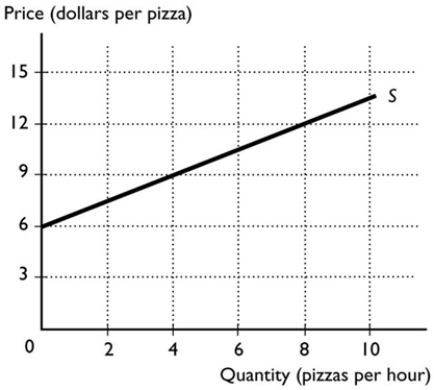
In the above figure, what is the marginal cost of the 4th pizza?
A) $9
B) $36
C) $4
D) $0
E) 4 pizzas

Unlock Deck
Unlock for access to all 130 flashcards in this deck.
Unlock Deck
k this deck
70
If the price is greater than the marginal cost of producing a good, the seller has
A) a loss.
B) no benefit from the sale.
C) some producer surplus from the sale.
D) some negative consumer surplus from the sale.
E) None of the above answers is correct.
A) a loss.
B) no benefit from the sale.
C) some producer surplus from the sale.
D) some negative consumer surplus from the sale.
E) None of the above answers is correct.

Unlock Deck
Unlock for access to all 130 flashcards in this deck.
Unlock Deck
k this deck
71
Hester owns an ice cream shop. It costs her $2 per cone to make 10 ice cream cones. If she sells 10 cones for $4 each, her producer surplus on the 10 cones is equal to
A) $40.
B) $10.
C) $4.
D) $2.
E) $20.
A) $40.
B) $10.
C) $4.
D) $2.
E) $20.

Unlock Deck
Unlock for access to all 130 flashcards in this deck.
Unlock Deck
k this deck
72
The supply curve is upward sloping because of
A) decreasing marginal cost.
B) increasing marginal benefit.
C) decreasing marginal benefit.
D) increasing marginal cost.
E) increasing total cost.
A) decreasing marginal cost.
B) increasing marginal benefit.
C) decreasing marginal benefit.
D) increasing marginal cost.
E) increasing total cost.

Unlock Deck
Unlock for access to all 130 flashcards in this deck.
Unlock Deck
k this deck
73

The figure above shows the supply curve for soft drink. The market price is $1.00 per soft drink. The producer surplus from the 10,000th soft drink is
A) $0.00.
B) $1.00.
C) $0.50.
D) more than $1.00.
E) None of the above answers is correct.

Unlock Deck
Unlock for access to all 130 flashcards in this deck.
Unlock Deck
k this deck
74
The cost of producing one more unit of a good or service is equal to its
A) consumer surplus.
B) marginal expenditure.
C) marginal cost.
D) marginal benefit.
E) producer surplus.
A) consumer surplus.
B) marginal expenditure.
C) marginal cost.
D) marginal benefit.
E) producer surplus.

Unlock Deck
Unlock for access to all 130 flashcards in this deck.
Unlock Deck
k this deck
75
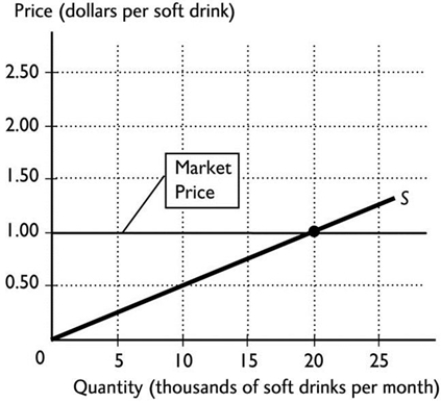
In the figure above, the equilibrium market price is $20. The producer surplus is shown by the area
A) A.
B) B.
C) A + B.
D) A - B.
E) A ÷ B.

Unlock Deck
Unlock for access to all 130 flashcards in this deck.
Unlock Deck
k this deck
76
The producer surplus of making and selling 10 chairs is found by
A) subtracting the marginal cost from the selling price for each chair and summing the differences for all 10 chairs.
B) adding the marginal cost and the price of all 10 chairs.
C) multiplying the selling price by 10.
D) subtracting from the total revenue the cost of producing one chair multiplied by 10.
E) None of the above answers is correct.
A) subtracting the marginal cost from the selling price for each chair and summing the differences for all 10 chairs.
B) adding the marginal cost and the price of all 10 chairs.
C) multiplying the selling price by 10.
D) subtracting from the total revenue the cost of producing one chair multiplied by 10.
E) None of the above answers is correct.

Unlock Deck
Unlock for access to all 130 flashcards in this deck.
Unlock Deck
k this deck
77

The figure above shows the supply curve for soft drink. The market price is $1.00 per soft drink. The producer surplus from all the soft drinks sold is
A) $1.00.
B) $0.00.
C) $15.00.
D) $20.00.
E) None of the above answers is correct.

Unlock Deck
Unlock for access to all 130 flashcards in this deck.
Unlock Deck
k this deck
78
A supply curve shows quantities supplied at various prices. It also shows the
A) marginal cost of production.
B) marginal benefit of the good.
C) total profit the firm earns at a given level of output.
D) producer surplus, which is equal to the slope of the supply curve.
E) total cost of production.
A) marginal cost of production.
B) marginal benefit of the good.
C) total profit the firm earns at a given level of output.
D) producer surplus, which is equal to the slope of the supply curve.
E) total cost of production.

Unlock Deck
Unlock for access to all 130 flashcards in this deck.
Unlock Deck
k this deck
79

In the figure above, the equilibrium market price is $20. Area A is the
A) marginal cost of 150th unit.
B) willingness to pay for the 150th unit.
C) marginal benefit of 150th unit.
D) producer surplus.
E) consumer surplus.

Unlock Deck
Unlock for access to all 130 flashcards in this deck.
Unlock Deck
k this deck
80

The figure above shows the supply curve for soft drink. The market price is $1.00 per soft drink. The marginal cost of the 10,000th soft drink is
A) $1.00.
B) $0.00.
C) $0.50.
D) more than $0.50 and less than $1.00.
E) None of the above answers is correct.

Unlock Deck
Unlock for access to all 130 flashcards in this deck.
Unlock Deck
k this deck



